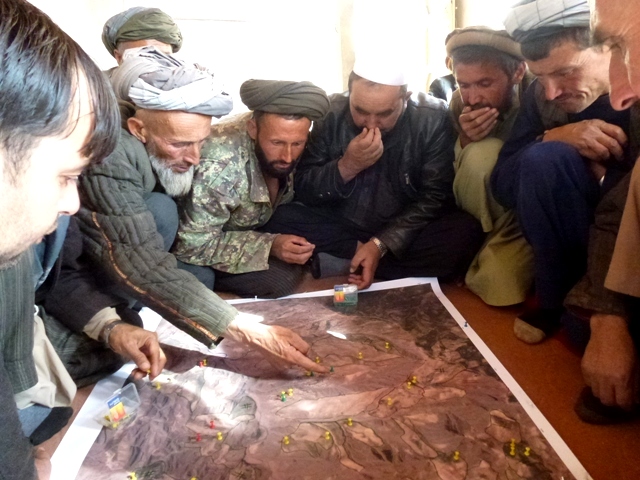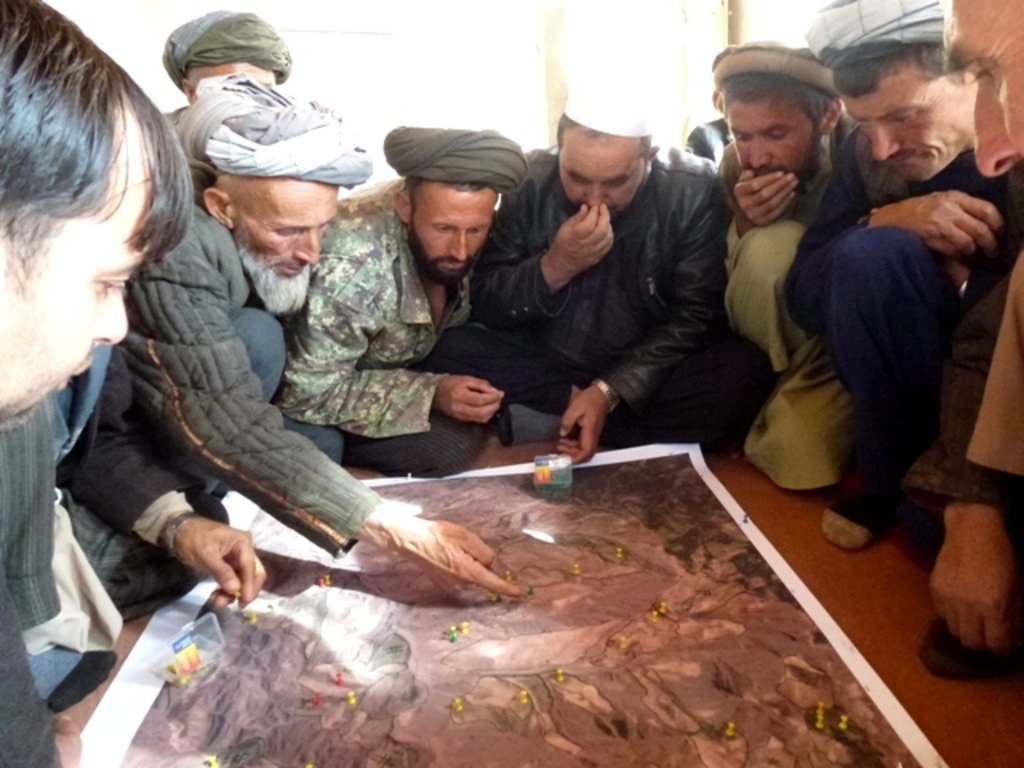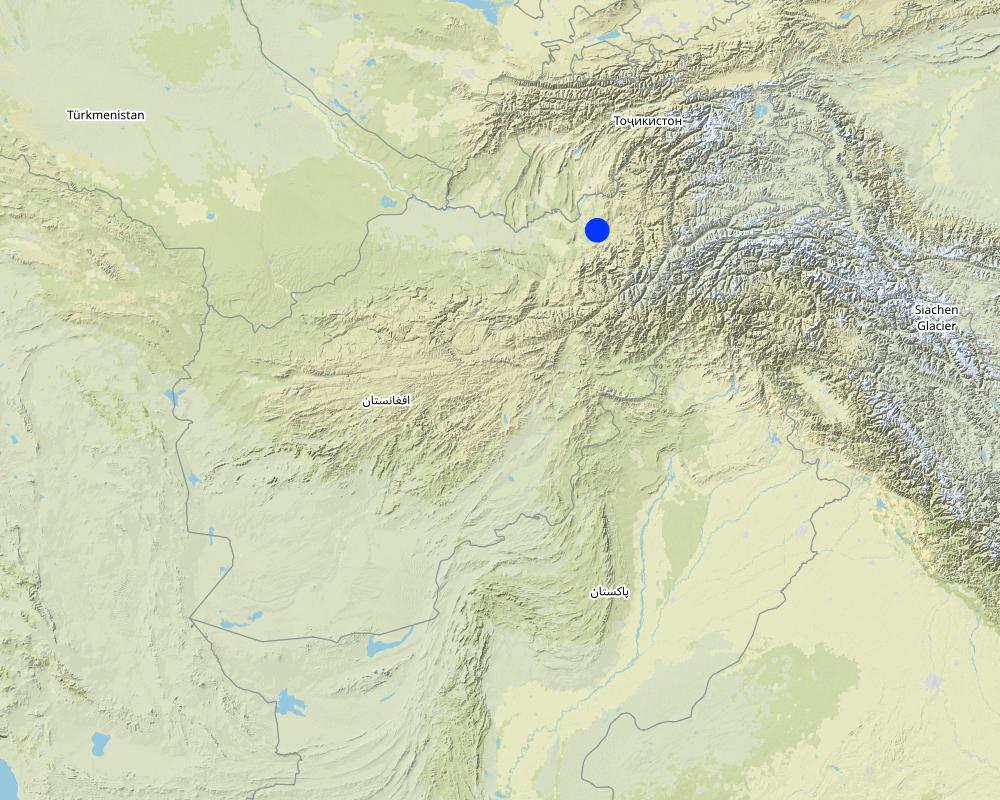Watershed Associations (WSA) and Natural Resource Management Committees (NRMC) [Afganistán]
- Creación:
- Actualización:
- Compilador: Bettina Wolfgramm
- Editores: Roziya Kirgizbekova, Aqila Haidery
- Revisor: William Critchley
approaches_545 - Afganistán
Visualizar secciones
Expandir todo Colapsar todos1. Información general
1.2 Detalles de contacto de las personas de referencia e instituciones involucradas en la evaluación y la documentación del Enfoque
Nombre del proyecto que facilitó la documentación/ evaluación del Enfoque (si fuera relevante)
Potential and limitations for improved natural resource management (NRM) in mountain communities in the Rustaq district, Afghanistan (Rustaq NRM Study)Nombre de la(s) institución(es) que facilitaron la documentación/ evaluación del Enfoque si fuera relevante)
Terre des Hommes (Terre des Hommes) - SuizaNombre de la(s) institución(es) que facilitaron la documentación/ evaluación del Enfoque si fuera relevante)
CDE Centre for Development and Environment (CDE Centre for Development and Environment) - Suiza1.3 Condiciones referidas al uso de datos documentados mediante WOCAT
¿Cuándo se compilaron los datos (en el campo)?
17/10/2016
El compilador y la/s persona(s) de referencia claves aceptan las condiciones acerca del uso de los datos documentados mediante WOCAT :
Sí
1.4 Referencia/s al/los Cuestionario(s) de Tecnologías MST
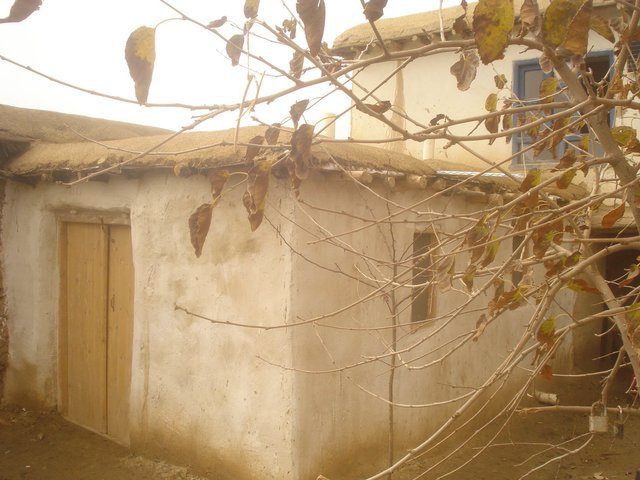
Improved livestock shed for better health and productivity [Afganistán]
Existing livestock sheds can be improved through interior and exterior refurbishing, and door and window installation. More favourable indoor conditions benefit animal health and the quality of animal products.
- Compilador: Bettina Wolfgramm
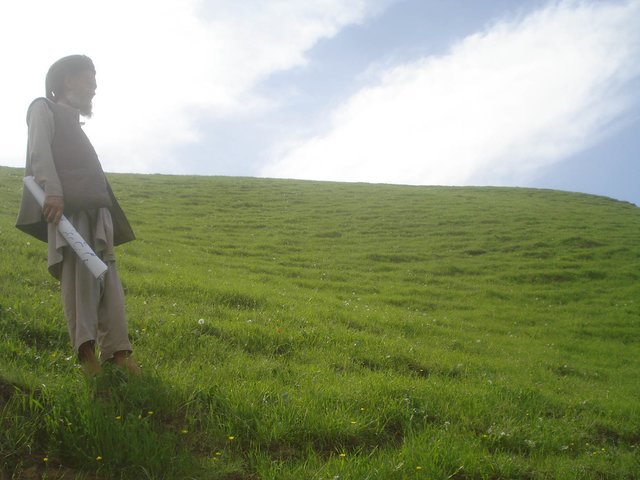
Rotational grazing to restore degraded pastures [Afganistán]
A plan for rotational grazing has been developed to control pasture use and prevent overgrazing of rehabilitated pastures.
- Compilador: Bettina Wolfgramm
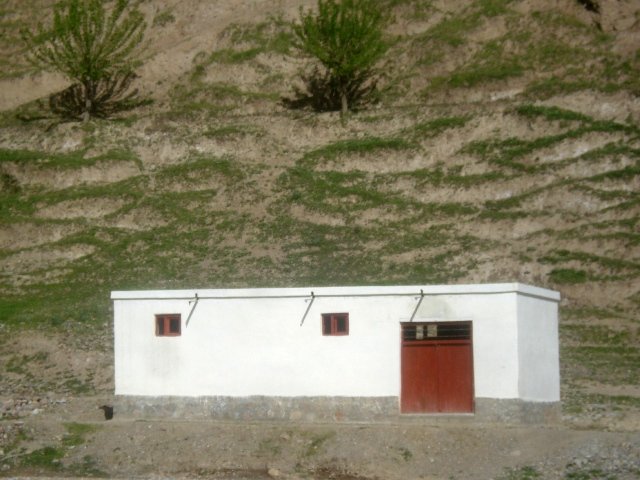
Community fodder bank for sustaining supplies [Afganistán]
Community fodder banks have been established in villages for the purpose of ensuring supplies of livestock fodder during winter, to prevent loss of livestock and to prevent over-grazing early in spring.
- Compilador: Bettina Wolfgramm
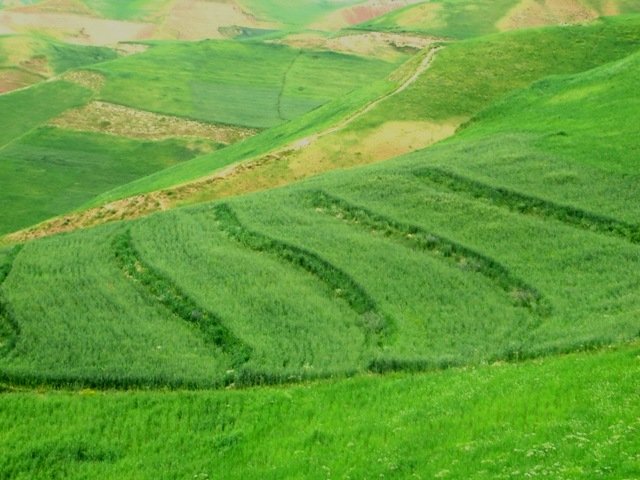
Terraces with improved seed and fertilizer application [Afganistán]
Terraces are established on mountain slopes used mainly for cropping wheat, with the purpose of soil protection from erosion, preserving runoff, sediments and nutrients on-site. Improved seeds and fertilizer are applied on the terraces for increasing crop yield, but also vegetation cover and biomass production, and thus prevent further land …
- Compilador: Roziya Kirgizbekova
2. Descripción del Enfoque MST
2.1 Breve descripción del Enfoque
Two Watershed Associations (WSA), in Chaker and Nahristan watershed areas respectively, are registered at the national level with the Ministry of Agriculture Irrigation and Livestock (MAIL) and at the regional level with the Department of Agriculture. Both associations are strong, active, dynamic, and have the capacity to coordinate and support the Natural Resource Management Committees (NRMC) at village level.
2.2 Descripción detallada del Enfoque MST
Descripción detallada del Enfoque MST:
Terre des Hommes (Tdh) has been implementing the Livelihood project (LIPT) in Rustaq district in northern Afghanistan since 2007. The overall aim of the project is to offer the rural population new and improved livelihood options, with capacity building of the rural population, to design and implement their own sustainable development options, and to enhance their resilience to cope with natural and conflict-related stress. For this purpose, capacity of supporting stakeholder institutions is strengthened (LIPT’s boundary partners) to ensure that good development is on-going. Boundary partners are trained and equipped in relevant techniques regarding sustainable natural resource management.
Two Watershed Associations (WSA) and 20 Natural Resources Management Committees (NRMC) were founded through LIPT. Two WSAs, in Chaker and Nahristan watershed areas, are registered at national level within the Ministry of Agriculture Irrigation and Livestock (MAIL), and at the regional level with the Department of Agriculture. Both associations are strong, active, dynamic, and have the capacity to coordinate and support the NRMCs at village level. Out of their newly established and registered regional offices, the WSAs coordinate the NRMCs, take over responsibilities from Tdh (e.g. the 2014 reforestation campaign) and are getting more involved in planning and monitoring of LIPT’s activities. The 20 NRMCs have "hands and eyes" on all LIPT activities implemented in their communities, and their trained extension workers render valuable services to the farmers in their villages.
Methods: Today, all NRMCs have a strong institutional set-up. Their extension workers have been trained and equipped. Members of NRMCs and WSAs have been trained on group management, planning, documentations, record keeping, IPM, reforestation management, soil protection, mulching, hedgerows and terracing, making fermenters, pruning and budding. WSAs and NRMCs gained further organizational, technical and management capacity building in both watershed areas. As one of biggest challenge at watershed level is soil erosion within hillside agriculture, LIPT III trained the NRMCs and WSAs on terracing and hedgerows to protect the soil from erosion. Furthermore, NRMCs were trained in sustainable irrigation water management, gully treatment, and surface water harvesting. There were also training courses conducted on leadership, finance, proposal writing, documentation, procurement and operations management.
Both WSAs and NRMCs started to get a real understanding of environmental issues and were then able to motivate their communities. WSAs coordinated the NRM intervention with NRMCs including reforestation, soil protection hedgerows, contour lines, terracing, establishment of public nurseries (to produce trees and be an income source for WSAs), establishment of centralized community bakeries (to reduce the demand for firewood and decrease the women’s workload in the watershed areas), irrigation infrastructure, bio-engineering and gully control (to reduce the progression of gullies on both ploughed lands and pastures), livestock value chains at regional (watershed) level, etc., while NRMCs are looking after these interventions and the mobilization of the community at the village level. Farmers and communities have adopted natural resource management practices to maintain/increase soil fertility, rangeland, water resources and forest coverage.
2.3 Fotos del Enfoque
2.5 País/ región/ lugares donde el Enfoque fue aplicado
País:
Afganistán
Región/ Estado/ Provincia:
Tahor Province, Rustaq districts
Especifique más el lugar :
Dashti Mirzai, Javaz Khana and Sari Joy villages
Map
×2.6 Fechas de inicio y conclusión del Enfoque
Indique año del inicio:
2007
Si no se conoce el año preciso, indique la fecha aproximada en la que se inició el Enfoque:
hace menos de 10 años (recientemente)
2.7 Tipo de Enfoque
- proyecto/ basado en un programa
2.8 Propósitos/ objetivos principales del Enfoque
The main aim of the project is to offer the rural population new and improved livelihood options and to deliver capacity building for the rural population to design and implement their own sustainable development options and enhance their resilience to cope with natural and conflict related stress.
2.9 Condiciones que facilitan o impiden la implementación de la/s Tecnología/s aplicadas bajo el Enfoque
normas y valores sociales/ culturales/ religiosos
- facilitan
The functions of men and women are clearly distinguished within Afghan society, while at the same time within the family this division of work and functions also results in men and women working hand-in-hand. An improvement of the family’s livelihood situation is expected to positively affect all family members. However. it is recognized that the involvement of women is key in order to secure basic human rights for everyone, to achieve good governance, sustainable development, and to efficiently contribute to poverty reduction (SDC 2004), it is also clear that a context sensitive approach is of high importance.
- impiden
Lack of capacity of the rural population to design and implement sustainable development options; vulnerability to natural and conflict related stress
entorno institucional
- facilitan
Establishment of Watershed Associations (WSA) and Natural Resources Management Committees (NRMC)
- impiden
Lack of institutions at the community level to introduce natural resource management options
conocimiento de MST, acceso a apoyo técnico
- facilitan
Training has improved technical knowledge
- impiden
Lack of technical knowledge
3. Participación y roles de las partes interesadas involucradas
3.1 Partes interesadas involucradas en el Enfoque y sus roles
- usuarios locales de tierras/ comunidades locales
The overall aim of the project is to offer the rural population new and improved livelihood options and give capacity building to the rural population to design and implement their own sustainable development options, and enhance their resilience to cope with natural and conflict related stress.
- organizaciones comunitarias
Watershed Associations (WSA) and Natural Resources Management Committees (NRMC)
- organización internacional
Terre des Hommes , SDC
3.2 Involucramiento de los usuarios locales de tierras/ comunidades locales en las distintas fases del Enfoque
| Involucramiento de los usuarios locales de tierras/ comunidades locales | Especifique quién se involucró y describa las actividades | |
|---|---|---|
| iniciación/ motivación | ninguno | |
| planificación | interactivo | |
| implementación | interactivo | |
| monitoreo y evaluación | interactivo |
3.4 La toma de decisiones en la selección de Tecnología(s) MST
Especifique quién decidió la selección de las Tecnología/ Tecnologías a implementarse:
- todos los actores relevantes, como parte de un enfoque participativo
4. Apoyo técnico, fortalecimiento institucional y gestión del conocimiento
4.1 Construcción de capacidades / capacitación
¿Se proporcionó la capacitación a usuarios de tierras/ otras partes interesadas?
Sí
Especifique quién fue capacitado:
- usuarios de tierras
- personal de campo/ consejeros
4.2 Servicio de asesoría
¿Los usuarios de tierras tienen acceso a un servicio de asesoría?
Sí
Especifique si servicio proporcionado se realizó:
- en los campos de los usuarios de tierras
4.3 Fortalecimiento institucional (desarrollo institucional)
¿Se establecieron o fortalecieron instituciones mediante el Enfoque?
- sí, moderadamente
Especifique el nivel o los niveles en los que se fortalecieron o establecieron las instituciones:
- local
- regional
- nacional
Describa la institución, roles y responsabilidades, miembros, etc.
LIPT III will leave behind successful and strong boundary partners in place to carry out the development options, as main boundary partners (WSAs, NRMCs, as the major boundary partners) will have a source of income for their operation and management.
Especifique el tipo de apoyo:
- financiero
- construcción de capacidades/ entrenamiento
- equipo
4.4 Monitoreo y evaluación
¿El monitoreo y la evaluación forman parte del Enfoque?
Sí
4.5 Investigación
¿La investigación formó parte del Enfoque?
Sí
Especifique los temas:
- economía/ marketing
- tecnología
Proporcione detalles adicionales e indique quién hizo la investigación:
On-going research, as well as multiple trials by LIPT to find the best-adapted technical solutions, to communicate and discuss them with local communities and farmers, were the key elements of this success.
5. Financiamiento y apoyo material externo
5.1 Presupuesto anual para el componente MST del Enfoque
Si no se conoce el presupuesto anual preciso, indique el rango:
- 10,000-100,000
5.2 Apoyo financiero/material proporcionado a los usuarios de tierras
¿Los usuarios de tierras recibieron financiamiento/ apoyo material para implementar la Tecnología/ Tecnologías? :
Sí
Si respondió sí, especifique el tipo o los tipos de apoyo, condiciones y proveedor(es) :
Fully supported under project
5.4 Crédito
¿Se proporcionó crédito bajo el Enfoque para actividades MST?
No
5.5 Otros incentivos o instrumentos
¿Se usaron otros incentivos o instrumentos para promover la implementación de Tecnologías MST?
Sí
Si fuera el caso, especifique :
local institution were support with equipment
6. Análisis de impacto y comentarios de conclusión
6.1 Impactos del Enfoque
¿El Enfoque ayudó a los usuarios de tierras a implementar y mantener Tecnologías MST?
- No
- Sí, un poco
- Sí, moderadamente
- Sí, mucho
NRM is the area where LIPT III made the most remarkable progress despite the fact that NRM was a completely new approach, and its implementation is highly demanding in terms of manpower, community awareness and mobilization. Profound changes in behaviour, motivation and mobilization both at individual and community levels made this possible. On-going research, as well as multiple trials by LIPT to find the best-adapted technical solutions, and to communicate and discuss them with local communities and farmers, were the key elements of this success. The NRMCs, WSAs as well as individual farmers in both watershed areas increased their knowledge and gained a better understanding of the importance of sustainable management, rehabilitation of farm land, pastures and their main natural resources. Farmers adapt and replicate the innovations once they see the results, farmers interest became high and they are ready to replicate it to protect their land form degradation.
¿El Enfoque mejoró el conocimiento y capacidades de los usuarios para implementar MST?
- No
- Sí, un poco
- Sí, moderadamente
- Sí, mucho
Farmers adapt and replicate the innovations. Once they see the results, farmers' interest became high and they are ready to replicate it to protect their land from degradation.
¿El Enfoque llevó a oportunidades de empleo, ingresos?
- No
- Sí, un poco
- Sí, moderadamente
- Sí, mucho
One Example: Under irrigation water improvement interventions, LIPT in coordination with NRMCs brought more 110 ha land under irrigation and the yield is expected to be doubled in this agricultural land, and NRMCs are trained on sustainable irrigation water management, gully treatment, and surface water harvesting
6.2 Motivación principal del usuario de la tierra para implementar MST
- producción incrementada
- reducción de la degradación del suelo
- reducción del riesgo de desastres naturales
6.3 Sostenibilidad de las actividades del Enfoque
¿Pueden los usuarios de tierras sostener lo que se implementó mediante el Enfoque (sin apoyo externo)?
- sí
Si respondió que sí, describa cómo:
To look to the capacity and institutional strengthening of the project boundary partners, LIPT III will leave behind a successful and strong boundary partner in place to carry out the development options, as main boundary partners will have source of income (nurseries, cooperative shop, etc.) for their operation and management.
6.4 Fortalezas/ ventajas del Enfoque
| Fuerzas/ ventajas/ oportunidades desde la perspectiva del usuario de la tierra |
|---|
| The traditional social structures and customary institutions play an important role in problem solving in everyday community life, but traditional problem solving structures may also limit the taking up of new approaches. More effective approaches are needed, for example in the field of the management of common pool resources (water, pastures, trees and shrubs). The newly established Watershed Associations demonstrate how groups addressing specific urgent tasks may be successfully established and functioning within a very short period of time. |
|
NRM is the area where LIPT III made the most remarkable progress despite the fact that NRM was a completely new approach, and its implementation is highly demanding in terms of manpower, community awareness and mobilization. Profound changes in behaviour, motivation and mobilization both at individual and community levels made this possible. The permanent research, as well as multiple trials by LIPT to find the best-adapted technical solutions, to communicate and discuss them with local communities and farmers were the key elements of this success. WSAs and NRMCs are playing an active role in implementation of NRM intervention, even they have become more interested and active when they registered in Department of Agriculture Irrigation and Livestock at national and regional level. |
| Farmers adapt and replicate the innovations once they see the results, as soil erosion is the main concern in Rustaq - but nobody in watershed area was ready to protect their agriculture land by implementing barrier hedgerows. After demonstrating of hedgerow by LIPT III, farmers saw its impact on controlling of soil erosion, farmers' interest became high and they are ready to replicate it to protect their land from degradation. |
|
All community extension workers are trained and in place, playing an essential role in supporting the boundary partners in implementing NRM activities that include community mobilization, technical design of orchards and nurseries, reforestation sites, terracing and hedgerow designs. The NRMCs, WSAs as well as individual farmers in both watershed areas increased their knowledge and gained better understanding of the importance of sustainable management, rehabilitation of farmland, pastures and their main natural resources. A high degree of motivation and mobilization of farmers, and adequate technical capacity of CEWs regarding NRM is certainly one of the main outcomes of the LIPT, and an essential step towards the fulfilment of LIPT’s mission. |
| Fuerzas/ ventajas/ oportunidades desde la perspectiva del compilador o de otra persona de referencia clave |
|---|
| A rewarding sign of the development of NRM awareness is how farmers took up the problem of soil erosion.100 ha of cultivable land on hillsides have been terraced since the terracing activity had been initiated in November 2013. And 155 ha of additional land are in the process of being terraced. The biggest success with terracing is that a number of farmers started replication themselves what they had seen. |
7. Referencias y vínculos
7.1 Métodos/ fuentes de información
- visitas de campo, encuestas de campo
- compilación de informes y otra documentación existente
Vínculos y módulos
Expandir todo Colapsar todosVínculos

Improved livestock shed for better health and productivity [Afganistán]
Existing livestock sheds can be improved through interior and exterior refurbishing, and door and window installation. More favourable indoor conditions benefit animal health and the quality of animal products.
- Compilador: Bettina Wolfgramm

Rotational grazing to restore degraded pastures [Afganistán]
A plan for rotational grazing has been developed to control pasture use and prevent overgrazing of rehabilitated pastures.
- Compilador: Bettina Wolfgramm

Community fodder bank for sustaining supplies [Afganistán]
Community fodder banks have been established in villages for the purpose of ensuring supplies of livestock fodder during winter, to prevent loss of livestock and to prevent over-grazing early in spring.
- Compilador: Bettina Wolfgramm

Terraces with improved seed and fertilizer application [Afganistán]
Terraces are established on mountain slopes used mainly for cropping wheat, with the purpose of soil protection from erosion, preserving runoff, sediments and nutrients on-site. Improved seeds and fertilizer are applied on the terraces for increasing crop yield, but also vegetation cover and biomass production, and thus prevent further land …
- Compilador: Roziya Kirgizbekova
Módulos
No se hallaron módulos


